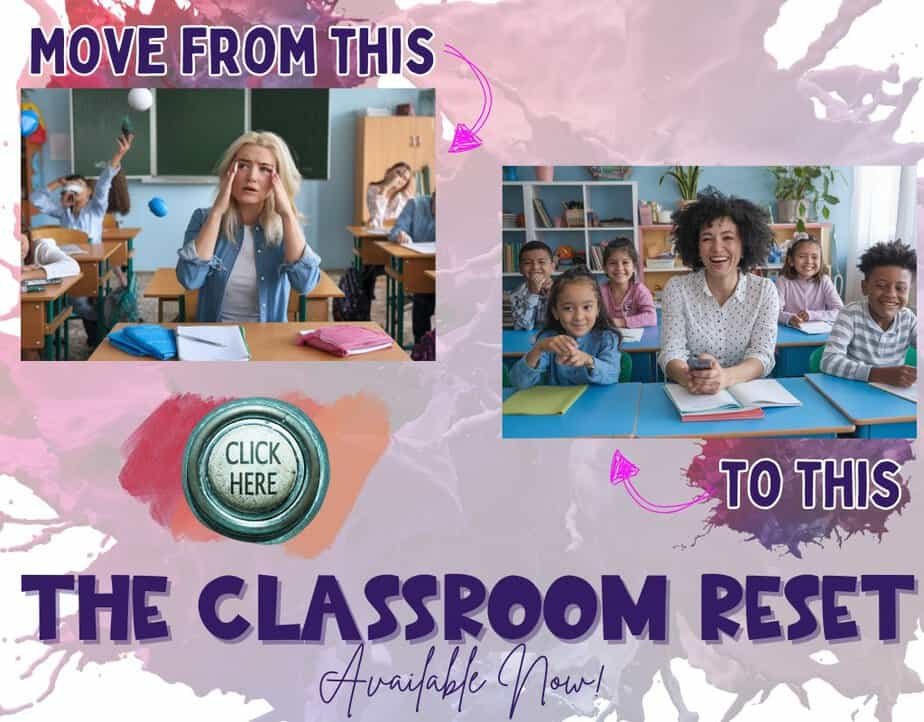Teacher Self Care: Tips and Strategies for Effectiveness
The teacher burnout signs are there, but way too often educators overlook the basic things they can do to accomplish effective teacher self care practices and aid in teacher burnout prevention.
I remember learning in one of my first years of teaching that the stress level of an educator is second only to that of an air traffic controller. While that statistic has changed over the years, the job of a teacher is still consistently in the top 5 of the most stressful jobs.
Teaching is one of the most rewarding yet demanding professions, and today’s educators face unprecedented challenges. The pressures on the teaching profession are at an all-time high, and teachers, by nature, pour their heart and soul into their work 24/7 during the school year—and often beyond. This relentless dedication can lead to high burnout rates, making self-care practices and prioritizing own well-being more critical than ever.

The importance of self-care cannot be overstated, as it directly impacts not only the teacher’s ability to perform but also the overall well-being of the school community and the young minds they nurture.
The Reality of Teacher Burnout
Teacher burnout is a widespread issue, with many educators overlooking simple yet effective self-care practices that can help prevent it. Studies have shown that teaching is consistently ranked among the top five most stressful jobs. The demands of the job—coupled with the emotional labor of supporting young minds—can take a toll on even the most passionate educators. The teaching profession requires not only academic instruction but also emotional support, life coaching, and often acting as a family member or mentor to students.
This multifaceted role can leave teachers feeling drained, especially when they neglect their own health.
According to a study by the University of Missouri, 93% of elementary school teachers report experiencing a consistently high level of stress, and this was before COVID-19. That means only 7% of the teachers surveyed said they had either lower levels of stress or had coping skills that correlated with the stress level that they were undertaking on a daily basis.
The summarizing article by Tim Walker states, that when teachers are given coping skills to help counteract stressful situations, they are incredibly open to the techniques that may help them. One of the researchers of the study, Keith Herman, is often shocked at the number of teachers who are unaware of techniques that he finds to be extremely basic in regard to reacting to stressful situations.
The importance of self-care becomes evident when we consider the long-term effects of burnout. Chronic stress can lead to physical health issues, such as fatigue, headaches, and a weakened immune system, as well as mental health challenges like anxiety and depression. For teachers, burnout doesn’t just affect their personal life—it also impacts their ability to be effective in the classroom.

An empty cup leaves little to give to students, and when teachers are running on empty, the quality of education suffers.
Why Self-Care Matters
Self-care isn’t selfish—it’s essential. Teachers are role models for their students, and modeling healthy habits like regular physical activity, mindfulness practice, and maintaining a balanced diet can have a ripple effect on the entire school community. However, many educators struggle to find time for intentional self-care amidst their long hours and packed to-do lists. The teaching career often blurs the lines between work and personal life, making it difficult to establish clear boundaries.
Here are some practical examples of self-care that can fit into a teacher’s daily life:
- Set aside time for deep breathing exercises or mindfulness techniques during the lunch break or between classes. Even five minutes of focused breathing can help reset your mind and reduce stress.
- Incorporate creative outlets like journaling, painting, or listening to favorite songs to unwind after a busy day. Engaging in creative activities can provide a mental escape and foster a sense of accomplishment.
- Prioritize enough sleep and limit screen time before bed to improve physical health and mental clarity. Sleep is a cornerstone of well-being, and without it, even the best things in life can feel overwhelming.
- Join support groups or connect with fellow educators to share common challenges and strategies for maintaining work-life balance. Building a network of support can help you feel less isolated and more understood.
Small Steps, Big Impact
For new teachers or those feeling overwhelmed, starting with small steps can make a significant difference. Here are some actionable ideas:
- Create a Routine: Schedule planning time and stick to it. Use an hourly planner to map out your day, including gym time, yoga class, or even a walk around the school building. Having a structured routine can help you feel more in control and reduce the chaos of daily life.
- Hydrate and Nourish: Keep a water bottle at your desk and aim to drink half your weight in ounces daily. Pack a healthy lunch to avoid relying on vending machines. Proper hydration and nutrition are foundational to maintaining energy levels and focus.
- Practice Mindfulness: Use a mindfulness app or try deep breathing exercises to center yourself during stressful moments. Mindfulness can help you stay present and reduce the impact of negative emotions.
- Set Boundaries: Learn to say no when your plate is full. Establish clear boundaries between your personal life and your teaching career. This might mean leaving work at a specific time or not checking emails after hours.
- Celebrate Small Wins: Acknowledge moments of joy and progress, no matter how small. These data points can help shift your mindset and reduce negative emotions. Celebrating small victories can build momentum and keep you motivated.
The Role of the School Community
While individual self-care practices are vital, the school’s culture plays a significant role in supporting educators. Administrators can foster a good place for teachers by:
- Encouraging work-life balance and respecting clear boundaries. This might involve setting policies that limit after-hours communication or providing flexibility in scheduling.
- Providing access to mental health resources and support groups. Schools can partner with social workers or counselors to offer workshops on stress management and emotional intelligence.
- Offering professional development on emotional intelligence and self-care matters. Training teachers in mindfulness techniques and stress management can equip them with tools to handle the demands of the job.
- Creating opportunities for creative activities or moments of joy during the school day. This could include staff wellness challenges, yoga classes, or even a dedicated space for relaxation.
The Bigger Picture
Teaching is more than a job—it’s a calling. But to be the best self for their students, educators must prioritize their own well-being. This means taking small steps toward intentional self-care, whether it’s through mindfulness practice, regular physical activity, or simply spending time with a close friend or family member. The teaching profession is inherently demanding, but by investing in self-care practices, teachers can sustain their passion and energy over the long term.
As we approach the new school year, let’s remember that self-care matters. By taking care of ourselves, we can better care for the young people who rely on us. After all, a good teacher who is in a good place mentally and physically can make all the difference in the lives of their students.

The teaching profession is filled with hard work, but it’s also filled with opportunities for growth, connection, and impact. By embracing self-care practices and prioritizing our own health, we can continue to inspire and nurture the young minds in our classrooms. Let’s commit to filling our cups so we can pour into others without running dry.
Remember, you are not alone in this journey. Lean on your fellow educators, seek out creative outlets, and take those small steps toward a healthier, more balanced life. Your best self is worth it—and so are your students. By prioritizing self-care, we not only improve our daily life but also set an example for the next generation of educators and learners. Let’s make self-care a non-negotiable part of our teaching career, ensuring that we can continue to make a positive impact for years to come.
The best change for MY teacher mental health
The greatest change I ever made in the classroom to help alleviate some of the stress was by adopting the student-centered model. As you know, Student-Centered World teaches teachers how to successfully execute that model in the classroom.
When I was able to walk into a room and everything was prepared for my students, I was able to literally speak to every single one of them in a meaningful way during class while I knew every other student was doing what they needed to do to achieve their highest level. This created such a sense of accomplishment and a relaxed feeling on my part in the classroom.

Is every single class perfect? No, of course not. Are there discipline issues that pop up? Of course, there are…we’re teaching kids, and it’s not going to be perfect…but knowing that most of the time it would be and that these interruptions were the exception and not the norm created an entirely different vibe in my room. Even my students would talk about how laid-back my classroom always felt and that they could do better there.
Having this run effectively takes a little extra preparation out of class, but when you’re able to enjoy your craft with your students, it changes everything. No longer will you enter class flustered, wondering if your lecture is going to be received well or in a way that your students understand. No longer do you have that unfortunate surprising moment after an assessment when many students didn’t do well because, of course, nobody had any questions when you asked.
By making your classroom learner-centered, you will be able to find out one-on-one what students are struggling with and will be able to adapt your class every single day for what they need more of (and in some cases less of).
This takes away the stress of teaching
That being said, not every day is rainbows and butterflies. Sometimes I would come up with an activity for the kids to pick from and they didn’t like it. so it didn’t go so well. I’m going to go out on a limb and say that you’ve tried things before that you didn’t like either.
Our students are human too, and we need to remember that.
It’s not a failure because you tried something and it didn’t work. It just didn’t work. You just have to find something different. Education has a trickle-down effect: how you’re treated by your superior is a direct correlation to how you perform and then treat others.
If your students feel like they’re respected in your classroom and are given some autonomy, watch how your classroom management issues start to disappear.
Change is scary, especially if you’ve been teaching the same way for a long time. One of the biggest backlashes I get from people about why they don’t want to switch to a student-centered classroom is because, “if it ain’t broke, don’t fix it”. While I don’t disagree with that, are you sure it’s not broken? Is every single student in your class achieving at their absolute peak level for them? Are they coming to school, excited to be there, and trying their very best (and taking risks in their learning because of it)?
This article was originally written on March 4, 2020
References:
Gonzalez, Jennifer. “Why It’s So Hard for Teachers to Take Care of Themselves.” Cult of Pedagogy, 20 Sept. 2018, www.cultofpedagogy.com/teacher-self-care/.
Mahnken, Kevin. “61% Of Teachers Stressed Out, 58% Say Mental Health Is Not Good in New National Survey.” The 74 The Problem With Homework Not Much Evidence on Whether It Works Comments, 21 Oct. 2017, www.the74million.org/61-of-teachers-stressed-out-58-say-mental-health-is-not-good-in-new-national-survey/.
Walker, Tim. “How Many Teachers Are Highly Stressed? Maybe More Than People Think.” NEA Today, 30 July 2018, neatoday.org/2018/05/11/study-high-teacher-stress-levels/.






